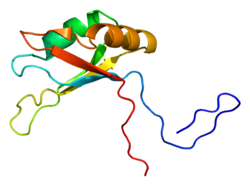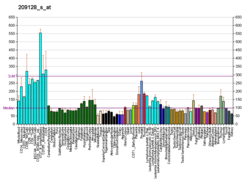Top Qs
Timeline
Chat
Perspective
SART3
Protein-coding gene in the species Homo sapiens From Wikipedia, the free encyclopedia
Remove ads
Squamous cell carcinoma antigen recognized by T-cells 3 is a protein that in humans is encoded by the SART3 gene.[5][6][7]
The protein encoded by this gene is an RNA-binding nuclear protein that is a tumor-rejection antigen. This antigen possesses tumor epitopes capable of inducing HLA-A24-restricted and tumor-specific cytotoxic T lymphocytes in cancer patients and may be useful for specific immunotherapy. This gene product is found to be an important cellular factor for HIV-1 gene expression and viral replication. It also associates transiently with U6 and U4/U6 snRNPs during the recycling phase of the spliceosome cycle. This encoded protein is thought to be involved in the regulation of mRNA splicing.[7]
Remove ads
Interactions
SART3 has been shown to interact with RNPS1[8] and Androgen receptor.[9]
References
Further reading
Wikiwand - on
Seamless Wikipedia browsing. On steroids.
Remove ads







